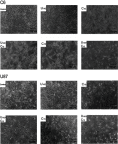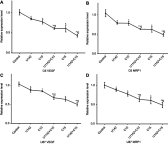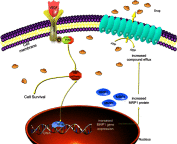The reversal of MRP1 expression induced by low-frequency and low-intensity ultrasound and curcumin mediated by VEGF in brain glioma
- PMID: 31190861
- PMCID: PMC6526172
- DOI: 10.2147/OTT.S195205
The reversal of MRP1 expression induced by low-frequency and low-intensity ultrasound and curcumin mediated by VEGF in brain glioma
Abstract
Purpose: To explore the effect of curcumin and low-frequency and low-intensity ultrasound (LFLIU) on C6 and U87 cell, and whether LFLIU could inhibit multidrug resistance protein 1 (MRP1) by increasing the sensitivity of curcumin via vascular epithelial growth factor (VEGF)/PI3K/Akt signaling pathway targeting. Methods: C6 and U87 cells were treated with various doses of curcumin and/or different intensities of LFLIU for 60 s. After 24 hrs, the effects of curcumin and/or LFLIU on the proliferation of C6 and U87 cells were examined. Real-time PCR and western blot analysis were used to detect the expression of VEGF and MRP1 at both mRNA and protein levels. The expression of MRP1 in C6 and U87 cells was also determined following stimulation with recombinant human VEGF and/or LY294002. Results: Curcumin and LFLIU inhibited the proliferation of glioma cells in an intensity- or dose-dependent manner. Furthermore, survivin was significant after combined treatment compares with that of curcumin or LFLIU treatment alone. VEGF and MRP1 were highly expressed in C6 and U87 cells, curcumin and LFLIU alone or in combination could decrease the expression of both VEGF and MRP1. MRP1 expression was down-regulated following LY294002 treatment, which blocked after exposure to VEGF. Conclusion: The synergistic effects, such as a higher inhibition rate, and lower expressions of MRP1 and VEGF, of combined curcumin and LFLIU against glioma was much better than that of a single treatment. The down-regulation of MRP1 may be related with the VEGF/PI3K/Akt pathway in glioma.
Keywords: LFLIU; MRP1; VEGF; curcumin; glioma cells.
Conflict of interest statement
The authors report no conflicts of interest in this work.
Figures









Similar articles
-
Vascular endothelial growth factor induces multidrug resistance-associated protein 1 overexpression through phosphatidylinositol-3-kinase /protein kinase B signaling pathway and transcription factor specificity protein 1 in BGC823 cell line.Acta Biochim Biophys Sin (Shanghai). 2013 Aug;45(8):656-63. doi: 10.1093/abbs/gmt062. Epub 2013 Jun 13. Acta Biochim Biophys Sin (Shanghai). 2013. PMID: 23765166
-
[VEGF shRNA enhances the sensitivity of multidrug-resistant leukemia cells to anticancer agent].Zhongguo Shi Yan Xue Ye Xue Za Zhi. 2011 Feb;19(1):34-9. Zhongguo Shi Yan Xue Ye Xue Za Zhi. 2011. PMID: 21362217 Chinese.
-
Curcumin targets vascular endothelial growth factor via activating the PI3K/Akt signaling pathway and improves brain hypoxic-ischemic injury in neonatal rats.Korean J Physiol Pharmacol. 2020 Sep 1;24(5):423-431. doi: 10.4196/kjpp.2020.24.5.423. Korean J Physiol Pharmacol. 2020. PMID: 32830149 Free PMC article.
-
[Nordy inhibits cell proliferation and angiogenic factor production of malignant human glioma cells mediated by formylpeptide receptor].Zhonghua Yi Xue Za Zhi. 2007 Feb 13;87(7):479-84. Zhonghua Yi Xue Za Zhi. 2007. PMID: 17459229 Chinese.
-
Curcumin enhances the radiosensitivity of U87 cells by inducing DUSP-2 up-regulation.Cell Physiol Biochem. 2015;35(4):1381-93. doi: 10.1159/000373959. Epub 2015 Mar 12. Cell Physiol Biochem. 2015. Retraction in: Cell Physiol Biochem. 2016;39(2):814. doi: 10.1159/000447791. PMID: 25792385 Retracted.
Cited by
-
The thiophene α-terthienylmethanol isolated from Tagetes minuta inhibits angiogenesis by targeting protein kinase C isozymes α and β2.Front Pharmacol. 2022 Oct 12;13:1007790. doi: 10.3389/fphar.2022.1007790. eCollection 2022. Front Pharmacol. 2022. PMID: 36313304 Free PMC article.
-
Characterization and comparison of human glioblastoma models.BMC Cancer. 2022 Aug 3;22(1):844. doi: 10.1186/s12885-022-09910-9. BMC Cancer. 2022. PMID: 35922758 Free PMC article.
-
Quinacrine and Curcumin in combination decreased the breast cancer angiogenesis by modulating ABCG2 via VEGF A.J Cell Commun Signal. 2023 Sep;17(3):609-626. doi: 10.1007/s12079-022-00692-0. Epub 2022 Nov 3. J Cell Commun Signal. 2023. PMID: 36326988 Free PMC article.
References
-
- Lamszus K, Ulbricht U, Matschke J, et al. Levels of soluble vascular endothelial growth factor (VEGF) receptor 1 in astrocytic tumors and its relation to malignancy, vascularity, and VEGF-A. Clin Cancer Res. 2003;9(4):1399–1405. - PubMed
LinkOut - more resources
Full Text Sources
Research Materials

